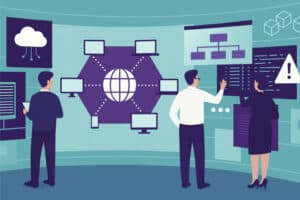2025 is poised to be a transformative year for retail supply chains, driven by technological innovation, heightened resilience, and a stronger push for sustainability. What does this mean for how we shop and work?
This is not just for supply chain executives but everyone else in the C-suite of retailer businesses. Understanding these trends is critical for staying ahead in a highly competitive landscape. Below, we explore five key trends, backed by data and real-life examples.
1. AI-Driven Supply Chain Optimization
Artificial intelligence (AI) is transforming how supply chains operate by enabling predictive analytics, demand forecasting, and real-time decision-making. According to McKinsey, AI-driven supply chain management can reduce logistics costs by 15% and inventory holding costs by 35%. We have seen these types of improvements across the e-commerce and retail businesses we serve, so these are realistic benefits you can expect from advanced planning systems powered by AI.
Retailers adopting AI for omnichannel supply chain optimization can improve customer satisfaction by ensuring product availability while reducing carrying costs. For example, AI can help prevent stockouts of popular items during peak seasons and holidays, ensuring consumers can find what they need when they need it in the most convenient way.
For instance, using Solvoyo’s AI-powered demand planning automation workflows, Unilever Ice-Cream business has significantly improved its inventory management by predicting customer demand with higher accuracy by leveraging several internal and external data sources, including price changes, POS data from retail chains, and weather data, reducing both stockouts and excess inventory.
A101, one of the fastest-growing retail chains in the world, has automated daily replenishment and purchasing decisions across its 13,000 stores and hundreds of distribution centers, leveraging an AI-driven integrated planning platform.
2. Autonomous Supply Chain Operations
Autonomous technologies, such as drones and autonomous guided vehicles (AGVs), are revolutionizing logistics and warehouse operations. A PwC report estimates that drones could save businesses up to $127 billion in logistics and supply chain applications.
Autonomous technologies reduce reliance on manual labor, accelerate delivery times, and minimize operational errors and supply chain costs as well. For consumers, this means quicker order fulfillment and more accurate delivery tracking, enhancing their overall shopping experience.
It all started with swift aerial deliveries of medical supplies to remote areas in Africa. Shortly after, it became evident that this model would also elevate commercial applications, mainly for retail and logistics, where drone deliveries could bring the most value to customers. Walmart’s implementation of drones for inventory audits in warehouses has reduced the time required for inventory checks from weeks to hours, enhancing operational efficiency.
3. Blockchain for Enhanced Transparency
A blockchain is a decentralized, distributed ledger that records transactions across multiple computers in a secure and tamper-proof way. Key features include:
- Transparency: All participants can access the same version of the ledger.
- Immutability: Once recorded, transactions cannot be altered without consensus.
- Decentralization: No single authority controls the data; instead, it’s managed collectively.
- Smart Contracts: Self-executing contracts with predefined rules, ensuring automatic and trustless execution of agreements.
Incorporating blockchain into retail supply chains improves efficiency, accountability, and sustainability, benefiting both businesses and consumers.
- Enhanced Traceability: Blockchain provides a transparent record of a product’s journey from origin to store shelves. Retailers can track and verify every stage, ensuring authenticity and ethical sourcing.
- Improved Inventory Management: Real-time data on inventory levels and movements allows better demand forecasting and reduces overstock or understock situations.
- Waste Reduction: By tracking product shelf life and conditions (e.g., temperature for perishables), blockchain helps identify and reduce waste from expired or spoiled goods.
- Fraud Prevention: Immutable records reduce the risk of counterfeit goods or false claims, safeguarding brand reputation.
- Faster Dispute Resolution: Transparent records and smart contracts can efficiently resolve disputes over shipments or payments, automating processes like payments on delivery confirmation.
- Consumer Trust: By scanning blockchain data (e.g., through QR codes), customers can verify product origin, quality, and sustainability, fostering trust and loyalty.
Walmart uses blockchain technology (developed with IBM’s Food Trust) to trace food products from farm to shelf. For example, the company can track mangoes or pork in seconds rather than days, ensuring food safety and quick recalls if contamination occurs. Similarly, French retailer Carrefour employs blockchain to provide detailed traceability of products like chicken, milk, and oranges. Customers can scan QR codes on packaging to access data about the product’s journey.
4. Sustainable Supply Chain Initiatives
Sustainability initiatives in retail are rapidly evolving as businesses align with growing consumer demand for environmentally conscious practices.
Sustainability is no longer optional; it’s a business imperative. Gartner predicts that by 2025, 50% of supply chain organizations will have incorporated circular economy principles. Here are some emerging trends that are gaining momentum across the industry:
Circular Economy Models
Retailers are increasingly adopting circular economy principles, focusing on product lifecycle management, including recycling, repair, and resale programs. This shift aims to minimize waste and efficiently use resources; however, reverse logistics costs are associated with these circular operations. Now, the next challenge for supply chain experts is to optimize the circular models and build efficient flows that are also sustainable commercially.
Carbon Footprint Reduction
Investments in renewable energy and sustainable sourcing are becoming critical as retailers strive to reduce their carbon emissions. Implementing energy-efficient technologies and optimizing supply chains are among the strategies employed to achieve these goals, but of course, they come with a cost. Network flow models employed by supply chain and logistics teams need to be enhanced with carbon calculators so businesses can estimate the total cost to serve both in terms of financial metrics and carbon footprint.
Transparency Through Technology
The use of digital technologies, such as blockchain, is on the rise. These technologies enable consumers to trace the ethical and sustainable origins of products, fostering trust and allowing for informed purchasing decisions.
Regenerative Agricultural Practices
Retailers are increasingly incorporating regenerative agriculture into their supply chains, focusing on farming practices that restore soil health and enhance biodiversity. This approach supports sustainable sourcing and contributes to environmental conservation, especially in sourcing fibers for the fashion industry. Cotton is one of the most environmentally destructive commodities; with the production of a single cotton T-shirt requiring around 2,700 liters of water and outsized amounts of polluting pesticides and fertilizers, it lends itself as a great candidate for regenerative agriculture to help reduce the textile industry’s environmental impact. Intercropping cotton with alternative tree species leads to improvements in soil health and reduction in water usage and helps control pests, reducing the need for expensive chemical inputs.
Retailers that prioritize sustainability gain competitive advantages, including enhanced brand reputation, cost savings from waste reduction, and alignment with consumer values.
Patagonia’s use of recycled materials, repair services, and its take-back program exemplify how sustainability can drive brand loyalty while reducing environmental impact. Armani Group’s collaboration on the regenerative cotton project in Italy aims to lower fashion retailers’ ecological footprint.
5. Real-Time Data and IoT Integration
The integration of the Internet of Things (IoT) has become one of the most important digital transformation technologies in improving the operational effectiveness of supply chains and logistics services. For supply chain management systems, IoT devices provide real-time visibility into inventory, transit conditions, and equipment health.
IoT enables real-time tracking of packages, allowing consumers to monitor deliveries with precision. It also ensures better freshness assurance for perishable goods like groceries and pharmaceuticals, giving consumers confidence in the quality of their purchases. MarketsandMarkets projects the global IoT Market will grow from $64.8 billion in 2024 to $153.2 billion by 2029.
Real-time data enables proactive inventory management, reducing stockouts and overstocks. It also reduces operational costs and supports sustainability initiatives through more efficient energy usage in HVAC systems and refrigeration. It automates supply chain tracking and improves accuracy while reducing manual labor. It improves supply chain resilience, ensures compliance with quality standards, and minimizes downtown and repair costs through predictive maintenance by monitoring equipment health. For consumers, this translates to fewer delays, better visibility into order status, and higher confidence in product quality, especially for sensitive items like food or medicine.
Walmart Utilizes IoT for real-time inventory tracking and energy management in its stores. Sensors monitor refrigeration units to ensure food safety and maintain optimal energy usage, reducing costs and improving service quality. Kroger implemented smart shelves equipped with IoT sensors to monitor inventory levels and display digital pricing. This technology ensures accurate pricing and enables dynamic pricing and timely restocking, enhancing the shopping experience.
Conclusion
The convergence of AI, autonomous technologies, blockchain, sustainability, and IoT is setting the stage for a transformative era in retail supply chain management. As these technologies mature, retailers and supply chain leaders who embrace them will not only enhance their operational efficiency but also deliver unparalleled value to their customers.
By leveraging these advancements, supply chain leaders can ensure better product availability, faster delivery times, and increased transparency, directly enhancing the consumer experience.
Ready to future-proof your supply chain? Start planning today to stay ahead of the curve. Talk to our team to start your journey with us.










